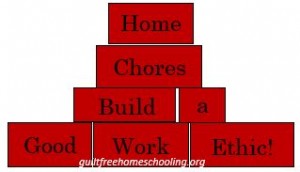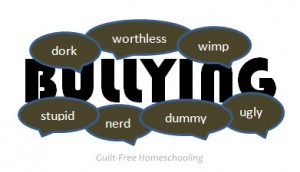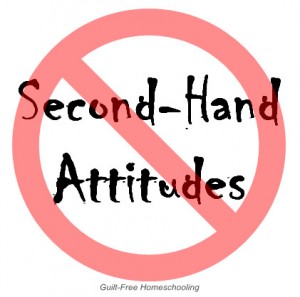It’s an ages-old debate: should kids be required to do regular chores around the house? My short answer is yes. Mom’s time is too valuable to be wasted on menial tasks. That doesn’t mean that Mom can’t or shouldn’t do them, but it does mean that those tasks that don’t require Mom’s unique talents can be done by anyone, not only by Mom. However, kids will need to be taught how to do a task correctly before they can succeed in it themselves.
Doing chores teaches skills, responsibility, and independence. Some day, for some unforeseen reason, Mom won’t be able to perform all of the household chores and pick up after everyone else. Whether that condition is temporary (such as a case of the flu) or more-or-less permanent (a debilitating health condition… or worse), Mom needs everyone’s help in keeping up. Incidentally, all those things Mom does are things the kids will eventually need to do for themselves in life, so they might as well suck it up and start doing them now to lessen the blow of reality. They might even find that ironing a few shirts provides an ideal time to organize their thoughts, besides making them look sharp at the job interview.
There’s a principle in economics called TANSTAAFL (say it as “tan-stay-awful”), an acronym for “There Ain’t No Such Thing As A Free Lunch.” I applied it to home chores as there are no free rides: everybody can do his share. If you plan to eat this food, you’ll willingly help carry the groceries in from the car and help put them away. As my kids got older, it morphed into “Hey, Mom! I’ll do that job for you, so you can do this job for me,” whenever my kids wanted me to help them with a special project (often making a new costume). They would lay out their proposal and then offer to do something for me (often making dinner), providing me with the necessary free time to bring their idea to fruition. Helping (bartering?) in this way taught them the vital concept of earning: you have to give to get something in return. The job-trading offers showed that they understood the most important part: every player is capable of contributing something to the Family Team.
Starting Young
My kids learned to help put toys away as soon as they were old enough to play with those toys. We stored our toys on open shelves in an assortment of shoeboxes, ice cream buckets, small dishpans, and recycled baby-wipes boxes, each labeled with a simple drawing for what items went inside. I worked side-by-side with my toddlers or preschool-aged kids to help them learn to sort out the toys and get everything put away (nearly) every afternoon before Daddy got home. They could still get something out to play with while I fixed supper, but the worst of the mess had been cleaned up. We made clean-up time into a game by calling out one type of toy and getting all of those put away before focusing on another one, starting with the largest items and working down to the smallest. Then as the kids got older and more adept at sorting and multitasking, they could handle the clean-up tasks themselves, freeing Mom to start cooking or laundry or any other higher-skilled task. By the time my kids were both school age, I had come up with a new clean-up game: I would challenge each of them to run through the house and find ten things that belonged to them and put those away. With a little more growing up, that game became known as 52-Pick-Up and was expanded to include anything that was out of place, if they knew where it belonged, not just their own personal items. They learned to appreciate the look of a tidy home and enjoyed the peacefulness that came with it, so it wasn’t difficult to get them to participate, especially because we played it as a game, and I praised them and thanked them for their diligence. Who doesn’t like being praised and thanked for their efforts? No one here!!
A child who never learns organizational skills grows up to be an adult who still doesn’t know how to organize or clean—I know because I was one. It is because I have struggled as an adult to learn how to organize myself that I began teaching my kids organizational skills as soon as they could pick up an alphabet block and drop it into a box. We played that first as a game to learn coordination, and then we continued to play it later on as a clean-up game.
Later on, I made each child a picture-chart for the bedroom wall to help them learn how to tidy things up in their rooms. A sheet of paper with simple cartoon-drawings showed a bed with wadded-up blankets and an arrow pointing to a neatly made bed, a jumble of clothes on the floor and an arrow pointing to the hamper, a pile of books on the floor and an arrow pointing to books on a shelf. Simple, homemade, but very effective. Teaching them to make the bed first provided a large surface to use for further sorting duties, again working from largest objects to smallest. My younger child felt it was a rite-of-passage, growing-up milestone when he got a picture-chart for his room—he was a big boy now, and he was old enough to learn how to tidy up his own room. He was still far from reading words, but he could read those pictures!
Learning Life-Skills
Yes, it does take longer to do a task with a child than it does to do it yourself. However, the time that is dedicated to teaching the child how to do the task himself will pay off in the days, weeks, months, and years to come. By spending the extra time required to teach my children how to do a task, I was ultimately freeing myself from doing that task in the future. Yes, I can pull a full bag of trash from the kitchen wastebasket, take it to the outdoor garbage can, and replace a new bag within a matter of seconds. Teaching my child to do that chore and walking him through each step could take ten minutes. However, he will get faster with practice, and I can eventually stop supervising and move on to my own tasks for those valuable ten minutes. Even if I only spent thirty seconds emptying the trash myself, that time adds up. If I include emptying every wastebasket in the house and if a larger family means more trash, that can become a serious waste of Mom’s time and talents. More importantly, the children won’t learn to take on the responsibility for that chore.
My kids learned to do many household chores through the years: keeping their rooms tidy; emptying the trash; emptying and filling the dishwasher; sweeping or vacuuming; dusting; cleaning bathrooms; mowing the lawn; carrying and putting away groceries; sorting, washing, drying, folding, hanging, ironing, and putting away laundry; and many other chores that I can’t remember. Some of these jobs were regularly scheduled tasks, and sometimes the kids were just asked to help out with other tasks. Yes, they needed reminders occasionally—we all do. Yes, there were times when they grumbled—we all do. Yes, there were times when Mom still did the job herself—the object here is teaching skills and responsibility, not giving Mom a life of unlimited leisure while someone feeds her grapes and fans her with palm fronds. Yes, there were times when a job wasn’t done perfectly—but that’s not the point—the point is that they learned how to do these chores, and they learned to own tasks as their responsibilities. Family is a team, with all players contributing something to the team; it is a tremendous help if those players can be interchangeable in certain areas. When everyone knows how to do a certain chore, life won’t ever come to a grinding halt while we all wait for the one, single soul who can perform the required task and get us all rolling along smoothly again.
This process of learning how to do chores is important for more reasons than just sharing in household duties as a child. This process is teaching life-long skills in decision-making, organizing, and taking responsibility. No one wants to live with an adult who thinks that if he ignores things long enough, the Trash Fairy will come and make the mess magically disappear. Or the Laundry Fairy, or the Dirty Dishes Fairy. Moms, if you don’t teach your children now how to do chores and how to take responsibility for doing them, who will? Do you believe that allowing your children to be sloths and doing everything for them will somehow transform them into conscientious adults? I’m sorry if this offends you, but if this is currently the case at your house, you are already being offended by children who disrespect you and treat you as their maid. The new guy on the job who leans back in his chair and rests his feet on his desk is an only-slightly-older version of the preteen who played incessant video games amidst empty soda cans, dirty dishes, and smelly socks, while an overworked Mom cleaned up around him. The young adult who expects to draw a paycheck while texting or checking social media on his cellphone is the same kid who never lifted a finger to help Mom or Dad with anything around the house—and worse, was never required to help.
What you teach your toddlers is what your youngsters will do automatically, and what you teach your youngsters is what your teens will do automatically, and what you teach your teens is what your young adult children will do automatically. It begins with sorting toys and putting them away, then progresses through taking out the trash and shuffling loads of laundry, and grows into someone who notices a task that is not being done and takes on the responsibility without waiting to be told that it’s his duty. I have known bosses who swept the floor because the lower-level employees didn’t think it was their duty to sweep. Sometimes it may not your assigned task, but you do have all the talent required. Teach your kids do look for tasks they can do at home, because it will pay benefits in the long run. As employees in that all-important first job, they will receive more positive feedback from taking the initiative to do a task (or asking if it’s okay to do it) than they will from standing around and waiting until someone else tells them to do it.
How to Do the How-To’s…
Start small—don’t expect your inexperienced teen to understand how to do multiple loads of laundry if he’s never had to hang up a single shirt. If your teen doesn’t know how to do laundry, start by showing him how to fold towels and work up from there. Help him master each crucial step before adding in more complications. It’s never fair or just or right to scold someone for doing a task incorrectly, if he’s never been properly taught how to do it.
Show & Tell—demonstrate the task and explain the critical parts. Example: explaining that a clothes hanger is a substitute for shoulders can teach how to hang a shirt straight. Talk about the various steps of the tasks you’re doing and explain the why’s for each step. Kids are more likely to do it your way if they understand the reasons behind why you do it the way you do it. I fold the towels this way so they will fit into this skinny cupboard. Also, specify which steps are required to be done a certain way and which steps can be done as the child wishes—giving him freedom to make it his job, not yours. It’s also helpful to the Family Team concept to listen to others’ suggestions of different methods. Mom is not God, and Mom can learn shortcuts from her spouse or kids. Been there, done that, changed my ways.
Let him try it—and don’t expect perfection or speed. Re-demonstrate any steps that are really crucial. Simple charts can come in handy here, too, such as how much detergent to put in the washer, what settings to use for different loads, and a reminder to clean out the dryer’s lint filter.
Give reminders—without nagging. No one enjoys being nagged. Set a very basic schedule for repeated tasks, such as “Make sure to empty all the wastebaskets and take the trash out by Thursday mornings, because the trash collection truck comes right after lunch on Thursdays.”
Say a sincere thank you—because everyone enjoys being appreciated. Hey, the trash is already emptied—and I didn’t even see you do that! Thank you!!
Keep it simple for success—even very complicated tasks can be learned one step at a time. Allow your child to keep trying until he gets a task done correctly, but do it by encouraging his progress, rather than scolding him for his failures. We worked for mastery in our homeschool lessons, believing that a concept wasn’t fully learned until a score of 100% had been reached. However, the child got to keep trying and keep correcting his work until he had mastered it. The same philosophy was used in learning chores and other tasks: keep trying until you get it right, keep working until you get it done. My daughter now works in a retail clothing store with many high-school-aged co-workers, and she finds their attitudes of “a just-barely-passing grade is good enough” to be completely unsatisfactory. Her work ethic of “keep at it until the job is done right” shows that she takes responsibility and personal pride in how the store looks and in how she serves her customers.
Teach your kids to be industrious by being industrious yourself—laziness breeds laziness. Don’t treat your kids as your servants by always asking them to fetch-and-carry for you, if you are fully capable of getting up and doing the same things yourself.
Teaching kids to help at home teaches them how to learn from others, something that will be very valuable in their future jobs. Teaching kids to do their assigned chores in a timely manner teaches them responsibility, again a valuable future skill. Teaching them to look for unassigned tasks they can do teaches them to take initiative, the most valuable skill of all. Being teachable, taking responsibility, and taking initiative combine to form an excellent work ethic, whether your child grows up to become a stay-at-home spouse or a corporate executive, and it starts with learning to pick up toys.
See also (in no particular order):
The Importance of Play in Education
Spoken Destinies & Learned Behaviors
Family Is Spelled T-E-A-M
Sorting Toys Is Algebra
I Give One Grade: 100%—But You Get to Keep Trying Until You Get It
Using Your Household Staff
Biblical Model of Discipleship
Pregnant & Homeschooling (great ideas for delegating, even if you’re not pregnant)
Full-Bodied Education: Mind, Body, & Spirit
We’re Not Raising Children – We’re Raising Adults
Respect Must Be Earned (good look at our attitudes toward each other)
Taming the Laundry Monster





 Guilt-Free Homeschooling is the creation of Carolyn Morrison and her daughter, Jennifer Leonhard. After serious disappointments with public school, Carolyn spent the next 11 years homeschooling her two children, from elementary to high school graduation and college admission. Refusing to force new homeschooling families to re-invent the wheel, Carolyn and Jennifer now share their encouragement, support, tips, and tricks, filling their blog with "all the answers we were looking for as a new-to-homeschooling family" and making this website a valuable resource for parents, not just a daily journal. Guilt-Free Homeschooling -- Equipping Parents for Homeschooling Success!
Guilt-Free Homeschooling is the creation of Carolyn Morrison and her daughter, Jennifer Leonhard. After serious disappointments with public school, Carolyn spent the next 11 years homeschooling her two children, from elementary to high school graduation and college admission. Refusing to force new homeschooling families to re-invent the wheel, Carolyn and Jennifer now share their encouragement, support, tips, and tricks, filling their blog with "all the answers we were looking for as a new-to-homeschooling family" and making this website a valuable resource for parents, not just a daily journal. Guilt-Free Homeschooling -- Equipping Parents for Homeschooling Success!

Recent Comments